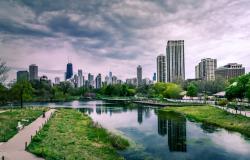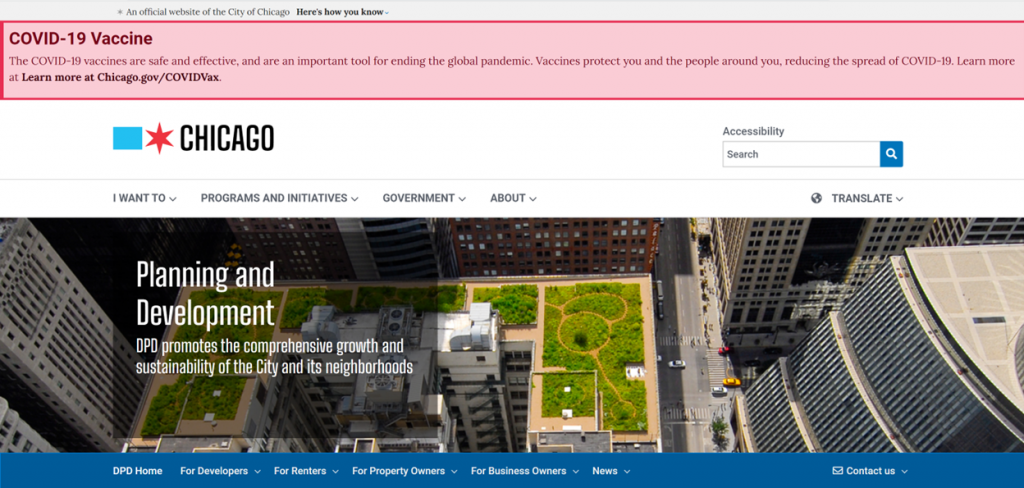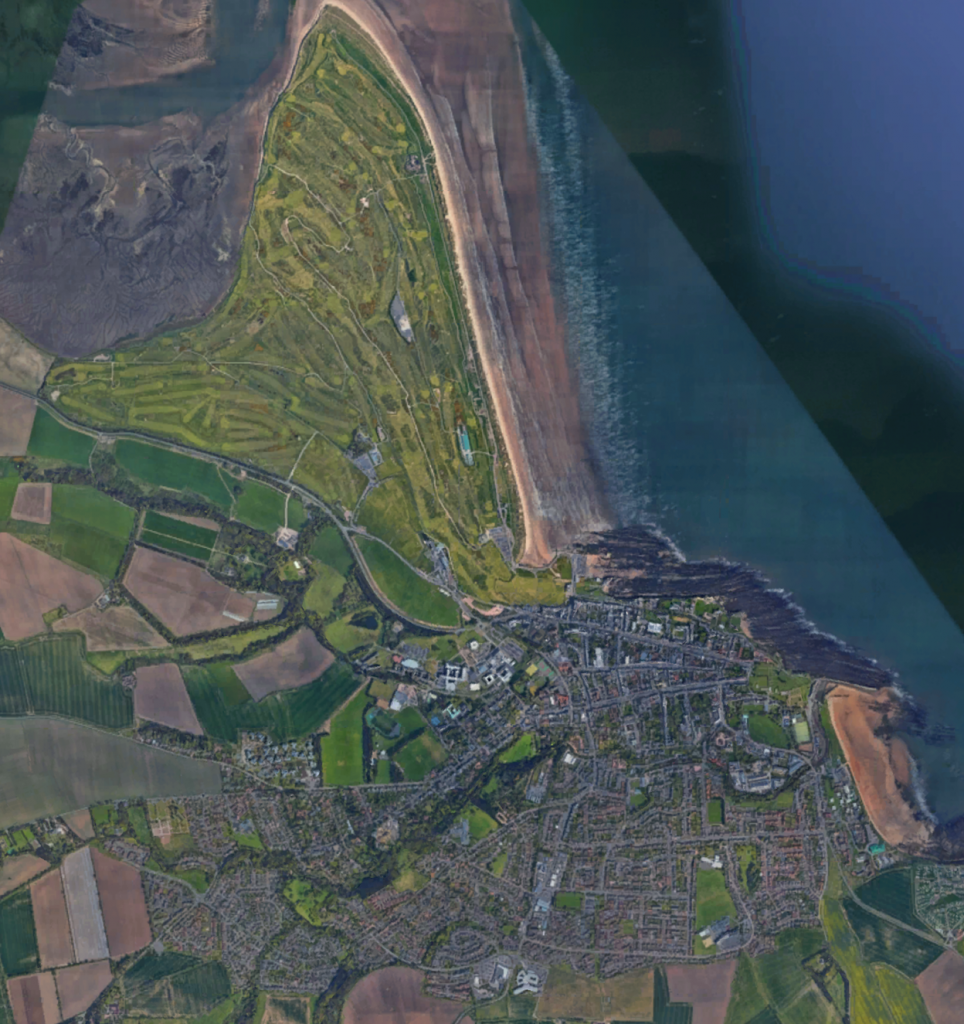St. Andrew’s X Marks the Spot: Fairways, Greens, and Green Spaces as a Policy Problem

Karl Muth asks what and who are urban 'green spaces' really for?
Some years ago, I walked amidst and upon the place of the very first golf course played according to modern rules, the Leith Links. Despite the word “links” being used, it is not out on the remote links (a word chosen to describe the otherwise-undevelopable spits of land around Scotland’s unforgiving coast), but right in the center of Edinburgh. On the second day in April of 1744, eleven golfers competed there to become “Captain of the Golf” on this spot that today feels (and even then felt, I imagine) more urban than pastoral and the course itself feels quaint and compact. Two hundred and seventy years later, in April of 2014, a small group of nerds in Scotland would gather here to celebrate its lone contribution to Unicode Version 7: the golf emoji.
That’s right, the current generation of the nation that brought us the Scottish Enlightenment and the steam engine contributed… a little golf icon. Cue a B-flat-to-G slide on the disappointment trombone.
As an economist who teaches both at a business school and in a masters of public policy program, and non-golfer, I am always stunned by golf courses as an emblem of waste or, at a minimum, suboptimal land use. No, strike that, such a minimum is too kind: golf courses are an incredible waste in every dimension: they are a waste of space, a waste of resources (most notably water), and a waste of time–though I’ll not argue that last one on this particular occasion. The places golf courses are most elaborate, expensive, and (yes, you know what’s coming) wasteful are the places where they’re most unnatural. Fly over the greater valley surrounding Palm Springs or Scottsdale, or the deserts of Dubai or Qatar, and it’s hard not to be struck by the presence of these bizarre, constantly thirsty, emeraldine bits, colonies of the Scottish sporting diaspora.
Golf courses in the desert, almond farms in drought-stricken zones, and submarine engines that are air-cooled all defy common sense, but the golf courses that trouble me most are not the ones built in the wrong climactic zone, but the ones built in the wrong plenary context; they’re in the midst of cities.
The role of golf courses in urban life and urban planning is not isolated to the oft-romanticized Edinburgh Leith Links or a new development in the perennially sunny Emirates (I’m looking at you, Abu Dhabi!). As recently as a few years ago, during the debate over whether the Obama Presidential Center should be allowed to cannibalize a chunk of the Jackson Park master plan zone (Jackson Park is one of Chicago’s great parks and the site of one of Chicago’s finest moments, hosting the World’s Columbian Exposition), it was a… you guessed it… golf course that found its way into the argument.
“Worry not,” advocates for Obamapalooza argued, “this is a mere twenty acres among the five-hundred-fifty that make up Jackson Park, a drop in the verdant bucket of green space.”
As Ludacris would say, “oh but hold up.”

Above: Jackson Park in Chicago is enormous and the entire acreage is claimed to be a great example of public “urban green space” according to the Mayor’s Office… but once you subtract out the marina, the large East Lagoon, and the golf course, there just isn’t a lot left of it. North of the athletic field to the far left is the 20 acres set aside for construction of the Obama Presidential Center.
Source: Google Earth, image captured by author on August 24, 2023 at 11:45 am CDT.
The original “links” in Scotland where golf was conceived and played before the modern rules were outlying, unwanted scraps of land wandered more by sheep than men and often used as a shortcut between hamlets more than as a place for recreation–they “linked” together otherwise-unreachable spits of land along the coast or among the lakes (today’s “water hazards” are aesthetic imitations of the natural hazards that surround these areas and an opportunity to build distributed retention ponds for the massive irrigation needs of 200+ acre golf courses). Unshielded from the sea and undeveloped in modernity, these harsh outcroppings of land look much as they did centuries ago, and it’s unlikely there will be a Starbucks built on them anytime soon. In short, they’re the polar opposite of a place like Chicago’s Jackson Park or the Presidio in San Francisco (150 acres!). The context of golf courses matters not only as new ones are built (a development or plenary policy problem) but as cities age and transform around existing courses (a land use and fundamentally allocative public goods problem).
Also, a golf course plays just the same whether it is surrounded by the Scottish edges of the North Sea, suburban Nevada McMansions, or Hong Kong-density apartment towers; there is no reason golf courses, if they must exist in a central urban setting, can’t be part of a higher-density plan. An example would be 粉錦公路地段1號, Hong Kong’s oldest golf course, now sandwiched between planned development on either side of Route 9 (Old Fanling Road) in Kowloon and ambitious development plans for formerly-sleepy Luk Mei Tsuen and Chau Tau Tsuen, which sit right across the Hong Kong SAR border from booming southern Shenzhen. If current development plans are to be believed, this golf course will perhaps have a view of the most buildings over fifty stories of any golf course in the world (a title currently claimed by the Jumeirah Golf Estates development’s adjoining course in Dubai).
Now let’s return to that five hundred fifty acre figure in Chicago, which includes in its ambit greenery just a few hundred yards from where I live; it disregards that roughly two hundred of those acres aren’t publicly enjoyable green space for picnicking or horseback riding or tree-climbing; they are part of a golf course. That’s right, the “green space” total of Jackson Park cited in numerous city council arguments, plenary documents, and petitions to build include the “green space” of a $34-per-person golf course in the total for Jackson Park. I don’t doubt golf courses, including this one, are green. But just as it’s somewhat misleading for Chicago’s mayor to lament 45,222 deaths from gun violence in 2020 (the 48,830 figure from 2021 is too hot-off-the-presses to make it into 2023’s Q3 speechwriting, apparently) without mentioning that 54 to 57% of these deaths were suicides (while suicide with a pistol both involves a “gun” and is “violent,” “gun violence” as a phrase conjures up visions of engaging in mutual combat rather than self-initiated demise), it’s a bit odd to use the mayor’s phrase “urban green space” to describe a manicured single-purpose sports field that costs $34 to access rather than a park.
Should these restricted, single-use spaces really be thought of as public green space?
Chicago’s City Hall has a green roof that is beautifully maintained (better than the Jackson Park fairways, some might argue) and that houses a wide variety of native flowers, grasses, and bushes, including ones rare to see in the city. But the roof of City Hall is not open to the public; it can only be enjoyed from nearby penthouse apartments or via Google Earth. The city counts the City Hall roof and other green roofs in the green space total, even though most are atop office buildings with strict lobby security and unwelcoming (or completely off limits) to out-of-town visitors, in-town greenery appreciators, and people who might want a nap in a park alike (Chicago’s Mayor Johnson might be a bit clueless as to how to deal with homelessness’s prevalence, but he’s sure doing great at limiting its altitude!). Is simply knowing there’s green space “up there” as you elevate your gaze to the gray edge of a building good enough? Or is part of the idea of green space that it should be enjoyable and accessible and that other green spaces (for instance, those with only a very limited purpose or those unable to be accessed by pedestrians) are functionally inferior and a bit dishonest to include in urban green space totals?

Above: The City of Chicago’s website shows off City Hall’s elevated park, not open to the public.
Screenshot taken by the author on August 24, 2023 at 11:44 am CDT.
And the contribution in percentage terms here isn’t trivial: over a third of the city’s claimed green space in its Loop, the central district of Chicago bounded by its elevated train, is green roof spaces, the majority of which are, as described above, not accessible to the general public.
Not only is including golf courses in green space totals for major urban areas a bit disingenuous, but its effect on green space totals is non-negligible, especially when one looks at certain areas with histories of housing discrimination and a historical shortage of green space for all to enjoy. The Jackson Park neighborhood used to be the private property of New-York-born Chicago real estate developer and white supremacist Paul Cornell, who installed racially-restrictive covenants in thousands of deeds in the area and loathed the idea of Jews, southern Europeans, Blacks, and Catholics enjoying the parks he’d been so generous to provide to his residents (if you’re interested in this history, I published an analysis of this issue not long ago). Not all green spaces are created equal, and not all can be credibly portrayed as equal public goods.

An aerial view of Chicago’s downtown “Loop” shows how little green space there is and how many of the larger green spaces are elevated on planes inaccessible to the public, including City Hall’s roof in the upper left quadrant, the Chicago Federal Building (access restricted even during business hours), and Block 37 (roof garden at penthouse level and only accessible to residents). The green roof incentives in Chicago under Zoning Ordinance 17-4-1015 do not require any public access to receive a FAR incentive.
Source: Google Earth, image captured by author on August 24, 2023 at 11:45 am CDT.
And though it’s easy to pick on Jackson Park in Chicago or the Presidio in San Francisco, there are lots of smaller cities in the U.S. that have an incredible amount of claimed green space but, upon closer inspection, actually have a ton of golf courses at the expense of other green space or public amenities. I’m talking about cities like Cincinnati (with a staggering 1.9 golf courses per 10,000 residents, only Aurora, Colorado has more golf courses on a per capita basis) and Minneapolis (1.7), cities that badly need more central public spaces with a sense of public ownership and a sense of invitation for public congregation.
These aren’t merely abstract, aesthetic considerations. Some have posited that if Minneapolis had more such spaces, the damage from the George Floyd protests wouldn’t have necessarily taken the same form or caused $2B in private property damage; protests away from open spaces where police must move down alleyways and around blind corners also put them in 10-foot to 50-foot close quarter combat scenarios with protesters, where violence and injuries are likely to be more severe, a staggering >15% of protesters who received medical care for their injuries from police encounters received “permanently disabling injuries” according to a recent study published in The New England Journal of Medicine. For perspective, USMC infantry manuals assert that anything within 110 yards is close-quarters combat. I’ve yet to hear someone argue (much less with a straight face) that another golf course would have been a great venue for those concerned about Mr. Floyd’s demise to have their voices heard.
I propose that courses like St. Andrews (which is on the edge of the town, not in the midst of it) are more convincingly municipally symbiotic while courses like the Presidio are essentially parasitic. Chicago has an example of such a symbiotic-to-the-city site, the par 72 Scottish-links-style Port Course (Harborside International Golf Center is the current branding), which was built during the Richard M. Daley administration on top of a network of landfills–what could be more Scottish and genuine than a golf course built on land nobody wants! The equivalent story in Boston would be the Granite Links course which (its name is a hint…) was built on the site of an old, contaminated granite quarry site. And the number one train in NYC will deliver you to Van Cortlandt (242 Bronx), which was more a swamp than anything else when the course was built (the same considerations have always made this area hard to develop; part of why Route 87 was allowed to take its path through the Bronx).

Above: The Old Course at St. Andrews (upper left) nearly matches the town in scale, but does not interfere with its planning and expansion (or that of the 600-year-old university of the same name).
Source: Google Earth, image captured by author on August 24, 2023 at 11:45 am CDT.
But it is worthwhile taxonomically, and I’d argue useful analytically, to bifurcate the golf course problem. On the one hand, you have existing courses that are not in ideal locations for cities’ present development arcs or are in areas ripe for development. On the other hand, you have planned courses that must convince sticks-in-the-mud like me that golf courses are truly a good use of central urban development space and should be considered green space rather than a frivolous giveaway to wealthy constituents.
In each case, you have three siting scenarios: 1) courses closer to the urban core or in areas ripe for development (like the Presidio), 2) courses that are (mis)represented as part of contiguous green space (like Jackson Park), and 3) courses that are in more harmless settings at the urban periphery (which may, in a generation or two in a rapidly-growing city, be Presidio-like).
As is often the case, there is something to be learned from Asian cities that were built or rebuilt (or substantially re-planned) in the modern era and had more choice (or options that could be exercised at lower cost) as to where golf courses would be located. Kyoto is one of Japan’s oldest cities (in the quasi-modern concept of a municipality, anyway) and was more than once Japan’s capital city, and substantial thought went into planning where its golf courses would reside. Golf is popular in urban Japan (a higher percentage of people 35-44 in Tokyo report golfing regularly than people in Chicago, New York, or Los Angeles). However, Japanese cities have complex and ever-changing land use rules, land is expensive, and cities are understandably reluctant to set aside huge tracts of central land for single-use purposes, even if the use involved is popular.
Kyoto has no eighteen-hole courses in its central districts and has denied several plans for development of golf courses in the green space that separates the older city center from newer development to the east (in the Yamashina Ward this development is particularly vigorous, drawing a proportion of foreign investment that is unusual outside of Tokyo). Though developers argued shrines and temples in this area would retain views across the valleys of the area (valleys that presumably would have been filled with fairways and bunkers and refreshment stations), conservationists and urban planners argued that looking across a course and seeing golf carts zip around below would substantially change the experience of visiting important, historical local temples (e.g., 東山慈照寺) or visiting a lookout along a hiking trail to Mt. Ushio (牛尾山).
Instead, golf courses reside at the edges of Kyoto, in many cases joined to the city by both highways and public transit. This means the Higashijoyo Golf Club, for instance, can be substantially south of the city while still being accessible to golf enthusiasts in Kyoto.
Two dangers unique to courses that already exist but are deemed candidates for redevelopment are the scale of the project (that it will be too ambitious or too large a parcel to suddenly drop into the market) and the risk the course will close but not be redeveloped (that the course closure will proceed as planned but redevelopment will not). This latter scenario happens more often than one might imagine, the FDR Course in Philadelphia being an example of a course closed in the hope the area would be developed. The course is now an overgrown swamp.
Perhaps the best-known piece of currently-underway litigation on this point is the sad story of Badlands Golf Course, which was about 240 acres of golf course in Queensridge, which is not on the Las Vegas Strip (named because it’s a long straight road like an airstrip, not for that reason, you dirty-minded reader!), but is right off the 159 and only twenty minutes from The Strip. From its closest edge, Queensridge is about nine crow-flight miles from The Strip, a distance similar to that from Jackson Park’s golf course to the Loop in downtown Chicago.
The City of Las Vegas has already paid tens of millions of dollars in damages to people who owned parcels in the golf course perimeter, which the city had hoped to re-parcel and sell; this doesn’t include interest owed or pecuniary remuneration if the taking of the golf course in the first place is found to have been an improper taking without compensation (at least five cases appear to be pending making this allegation or substantially similar allegations). Nearby, large homes sell for $2M to $4M and a mixture of federal land, easements, and poorly placed developments like Badlands Golf Course constrict further residential development of the valley.
Stalled redevelopment of golf courses that have ceased operations are no doubt problematic, but this does not mean we should not have a wholesale referendum conversation around the role of golf courses, how they interact with the surrounding area, and why (or why not) to have them in these locations. They should not be confused for parks or publicly accessible, versatile green space and should not be extraordinarily subsidized or protected in ways other parks are not. The redevelopment for distinct use of any land involves risk to investors and to the community and not all projects work out; however, this is an area ripe for experimentation and where mayors and others could be more courageous.
When golf courses are turned into something that provides housing or enjoyment for more people, that’s great. When golf courses are replaced by other courses at the edge of the city that can have a more symbiotic relationship with the city’s population, that’s great. When golf courses can be shut down in an orderly way with a committed-capital, shovel-ready development plan in place, that’s of course ideal (but not always possible).
But when golf courses sit and metastasize in the midst of the urban plan and survive by disguising themselves as “green space” in one speech and something else in another, it’s time to examine what these spaces really are, what they represent, how they’re used, and whether we can afford the footprint opportunity cost of having such large tracts of land dedicated to such a limited recreational purpose. Opportunity cost is the right measure, as modern urban planning is not simply the prescriptive or plenary science of allocating land to uses, but also the ruthless auditing of present uses against that tract’s potential value in all/any other uses. And golf courses should not be exempt.
Karl T. Muth teaches at the University of Chicago’s Booth School of Business; he also has taught for over a decade teaching at Northwestern University, where he was the youngest-ever person appointed to teach across five disciplines (economics, law, organizational behavior, public policy, and statistics). He lives on Chicago’s south side near Jackson Park and doesn’t golf.
Daniel Wang is a graduate of Northwestern University and lives in New York City.
Photo by Nancy Bourque


